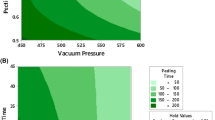Abstract
A process for obtaining fruit segments from a traditional orange of Sangrina variety by enzymatic peeling was optimized. Enzymatic peeling was carried out by fruit infusion under vacuum conditions in a commercial preparation of pectinases and cellulases (Peelzym II). For the optimization of vacuum conditions, the potential enzymatic saturation of albedo was determined. To obtain a final product with good quality, it was necessary to prove the effectiveness of different concentration of Peelzym II for the degradation of the fruit albedo and also the incubation time of the fruits with the enzymatic solution. The best condition to obtain Sangrina segments by enzymatic peeling was 1 ml L−1 of Peelzym II applied at 67 kPa with two vacuum pulses of 2 min and a subsequent period of 40 min in the enzymatic solution at atmospheric pressure. The reuse of the enzyme preparation in an industrial peeling process was also studied. Results show that it is possible to reuse the enzymatic preparation in an industrial peeling process, although a 30% decrease in the pectinase activity occurred after four peeling cycles.




Similar content being viewed by others
References
Rivera D, Obón C, Ríos S, Selma C, Méndez F, Verde A, Cano F (1998) In: Marin D (ed) Las variedades tradicionales de frutales de la cuenca del río Segura. Catálogo etnobotánico. Cítricos, carnosos y vides, Murcia, Spain
Pretel MT, Fernández PS, Martínez A, Romojaro F (1998a) Z Lebensm Untersuch A 207:322–327
Ben Shalon N (1986) J Food Sci 51:720–730
Bruemmer JH, Griffin AW, Onayami O (1978) Proc Fla State Hort Soc 91:112–114
Berry RE, Baker RA, Bruemmer JH (1988) In: Goren R, Hendel K (ed) Proceedings of the sixth international citrus congress, Tel-Aviv, Balaban Publishers, Philadelphia, pp 1711–1716
Pretel MT, Amorós A, Botella MA, Serrano M, Romojaro F (2005) J Sci Food Agric 85:86–90
Bruemmer JH (1981) Method of preparing citrus fruit. Sections with fresh fruit flavor and appereance. US Patent 4.284.651
Baker RA, Bruemmer JH (1989) In: Jen JJ (ed) Quality factors of fruits and vegetables. American Chemical Society, Washington, DC, p 140
Soffer T, Mannheim CH (1994) Lebensm Wiss Technol 27:245–248
Pretel MT, Lozano P, Riquelme F, Romojaro F (1997) Process Biochem 32(1):43–49
Prakash S, Singhal RS, Kulkarni PR (2001) J Sci Food Agric 81:1440–1442
Rouhana A, Mannheim CH (1994) Lebensm Wiss Technol 27:103–107
Pretel MT, Botella MA, Zapata PJ, Amorós A, Serrano M (2004) Eur Food Res Technol 219:474–478
Kimball DA (1999) Citrus processing. A complete guide. Aspen, Gaithersburg, MD
Pretel MT, Botella MA, Amorós A, Zapata PJ, Serrano M (2007) Lebensm Wiss Technol 40:12–20
Baker RA, Wicker L (1996) Trends Food Sci Technol 7:279–284
Toker I, Bayindirli A (2003) Lebensm Wiss Technol 36(2):215–221
Pretel MT, Fernández F, Romojaro F, Martínez A (1998b) Lebensm Wisst Technol 31:322–328
Coll L (1996) Polisacáridos estructurales y degradación enzimática de la membrana carpelar de mandarina Satsuma (Citrus unshiu Marc.). Pelado enzimático de los segmentos. Tesis Doctoral, Universidad de Murcia
Author information
Authors and Affiliations
Corresponding author
Rights and permissions
About this article
Cite this article
Pretel, M.T., Botella, M.Á., Amorós, A. et al. Obtaining fruit segments from a traditional orange variety (Citrus sinensis (L.) Osbeck cv. Sangrina) by enzymatic peeling. Eur Food Res Technol 225, 783–788 (2007). https://doi.org/10.1007/s00217-006-0482-y
Received:
Revised:
Accepted:
Published:
Issue Date:
DOI: https://doi.org/10.1007/s00217-006-0482-y




